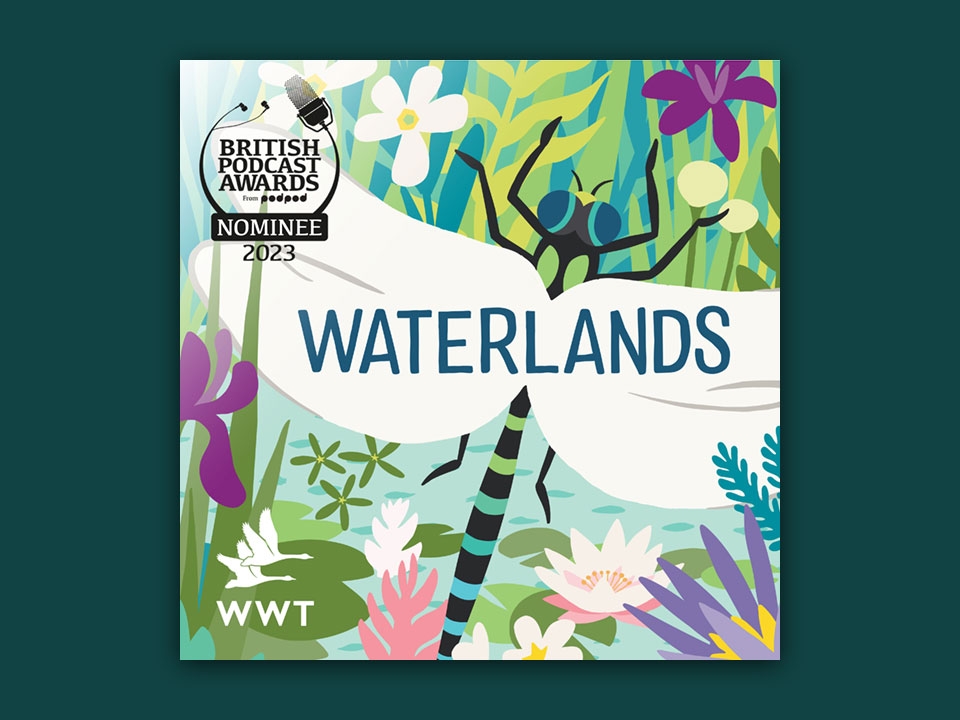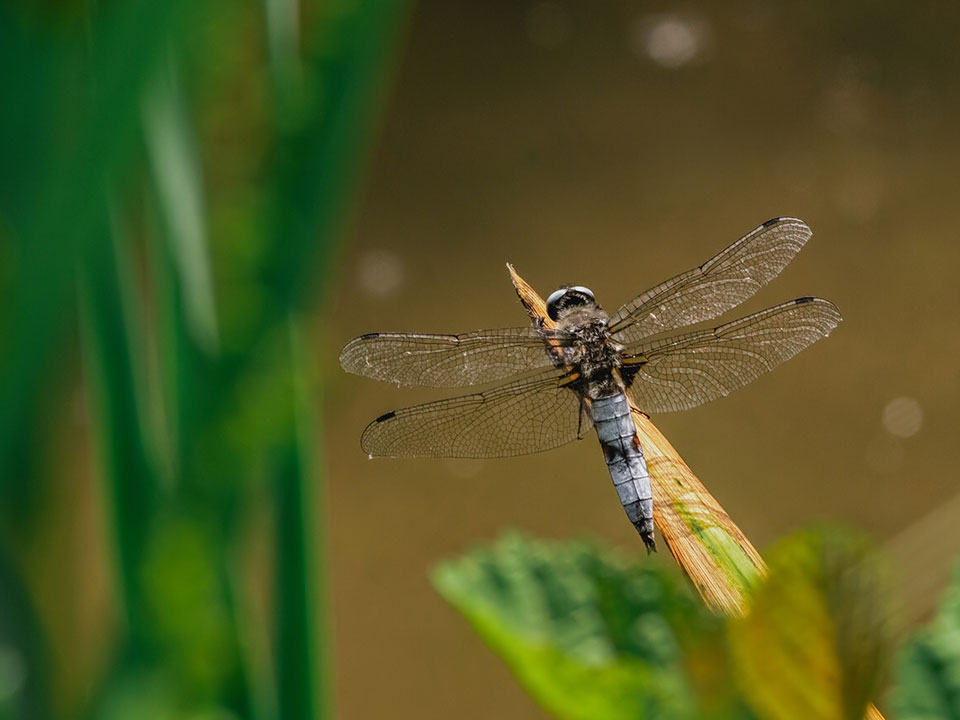Dragonflies and damselflies

Ready to dive into the world of dragonflies?
Dragonflies are some of nature’s most dazzling creatures, with their shimmering wings, acrobatic flight, and vibrant colours. They’re not just beautiful – they’re also incredibly important!
At WWT, we’re passionate about protecting the wetlands that dragonflies depend on. These rich, watery habitats are where they hatch, hunt, and thrive – making them vital not just for dragonflies, but for countless other species too. By looking after wetlands, we’re helping these incredible insects continue to flourish.
Want to get to know them better? Let’s buzz through some fun facts, answer your burning questions, and help you start spotting and identifying dragonflies like a pro.
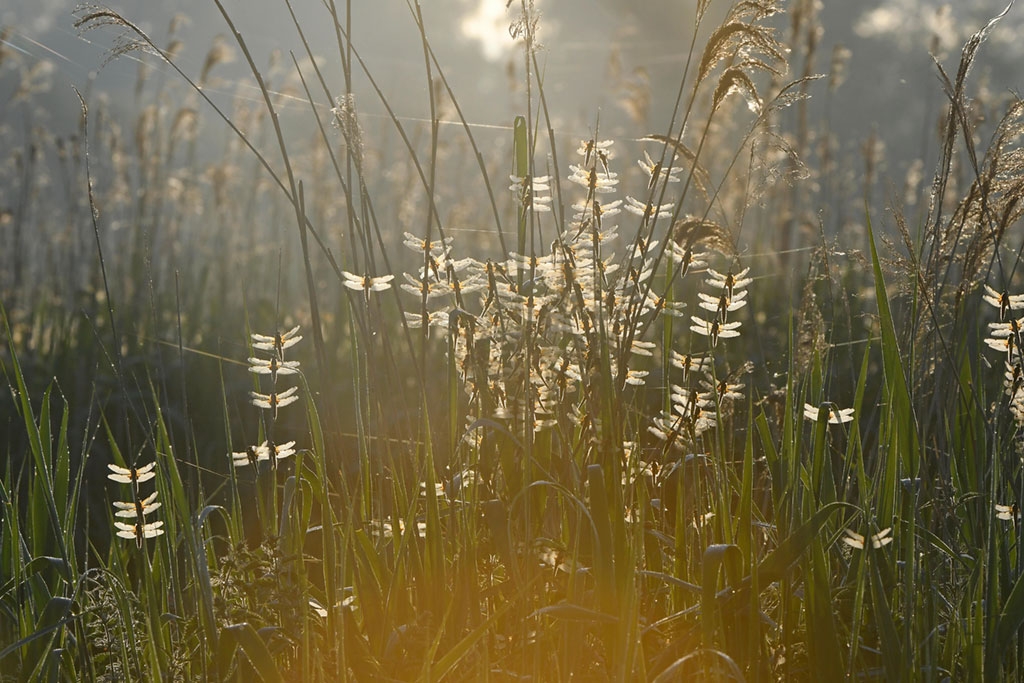
How do I know it’s a dragonfly?
Think you’ve spotted a dragonfly? Learn the tell-tale signs that set these aerial acrobats apart.
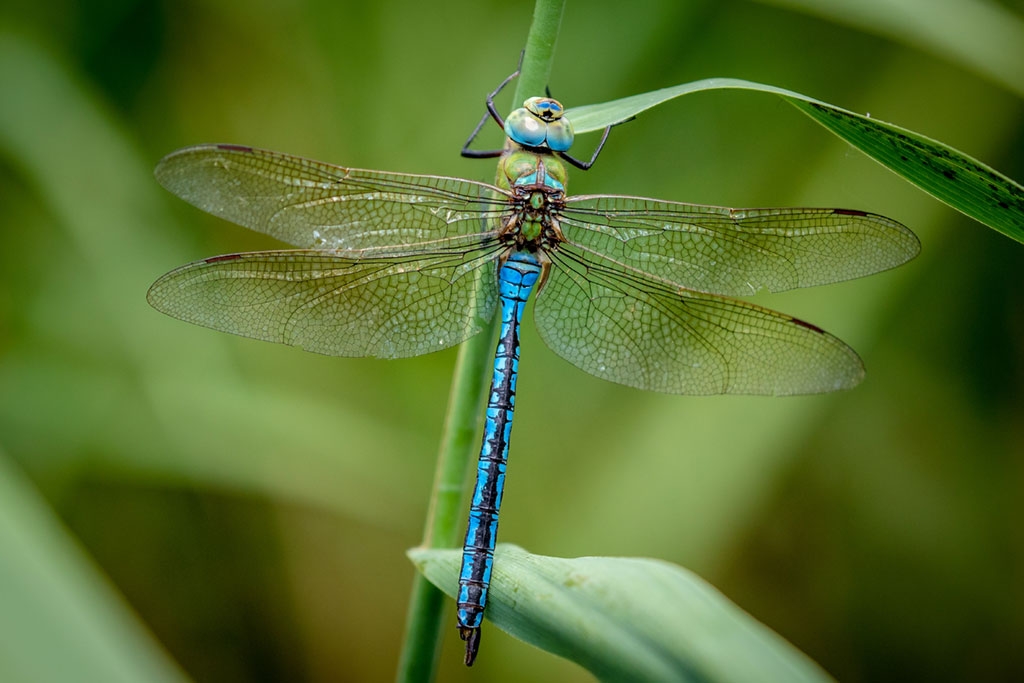
Where do dragonflies live?
Wondering where to spot a dragonfly? From glistening ponds to lazy rivers, we’ll suggest the best places where you can find these shimmering flyers in action.
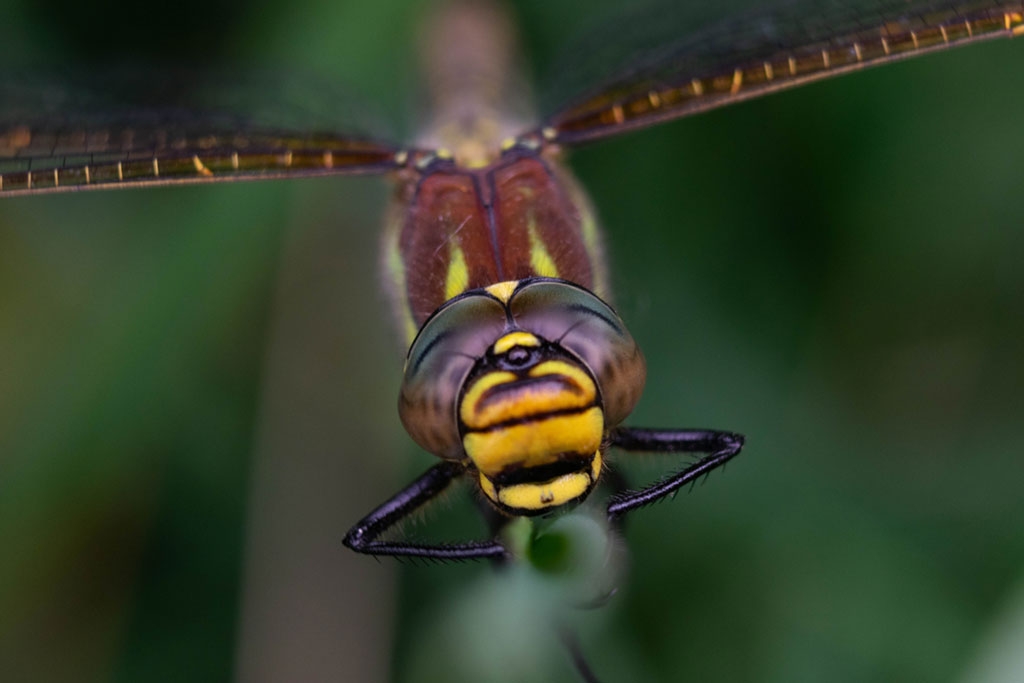
Dragonfly behaviour
Ever wondered how dragonflies hunt, fly and see the world and whether they bite or sting? (Spoiler alert: they’re all flash, no sting!)
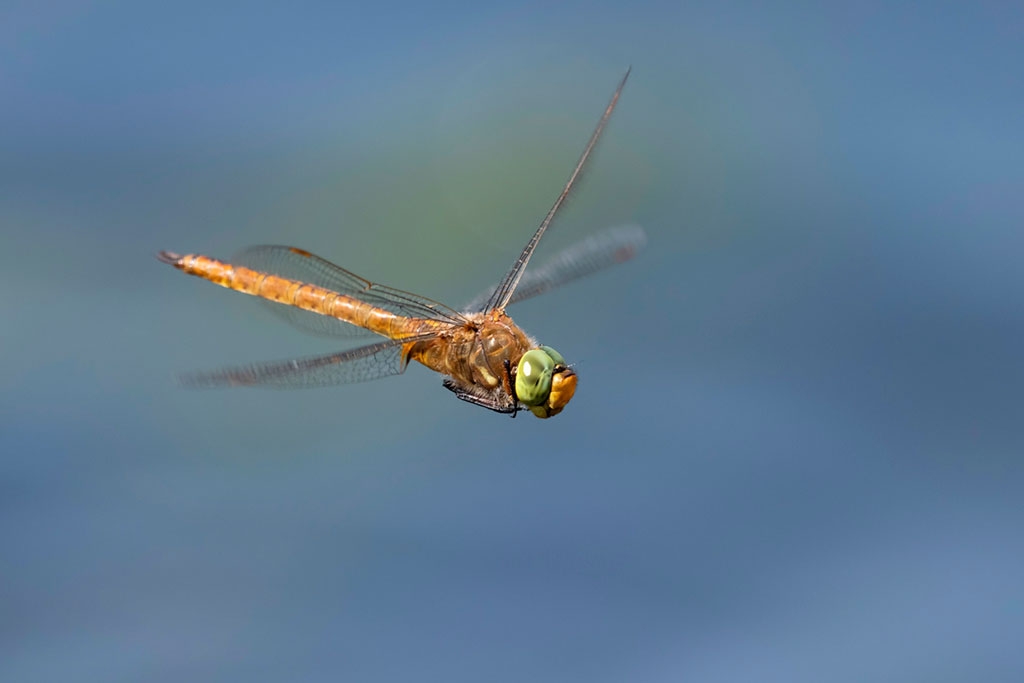
Helping dragonflies
Want to give dragonflies a helping hand? It’s easier than you think and it starts right in your own garden.
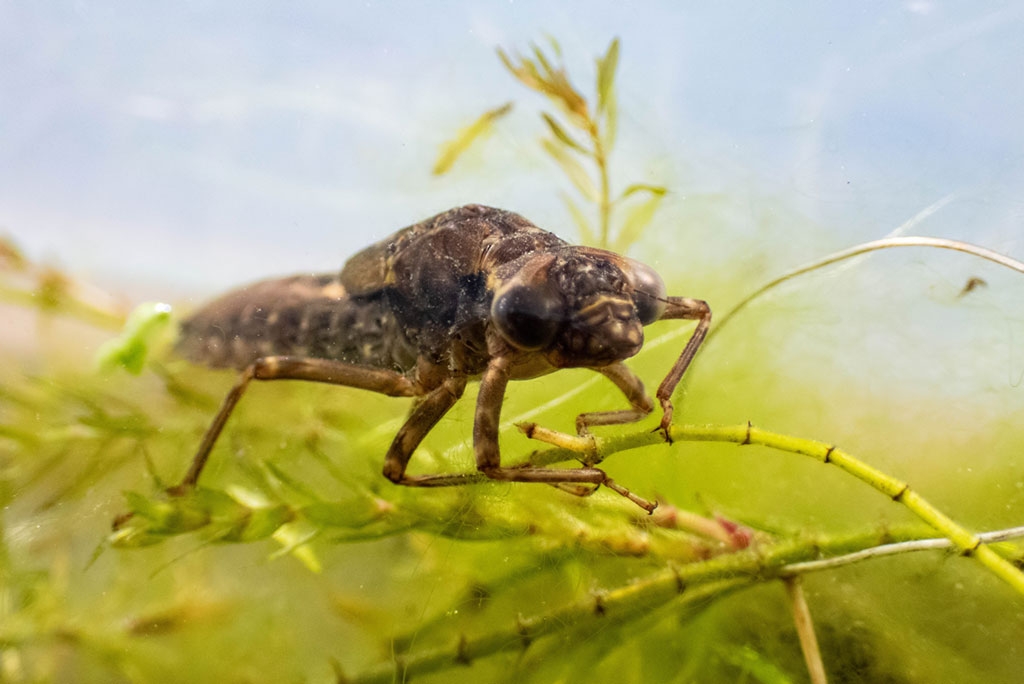
What dragonfly and damselfly species live in the UK
Globally dragonflies can be found on every continent except Antarctica, with over 5,000 species flying around the globe.
In this guide we’ve covered the 30 species that are widespread or common in certain areas of the UK. Colours of the thorax (the body part where the wings attach) and abdomen (the long, tail like part) are often key to identification!
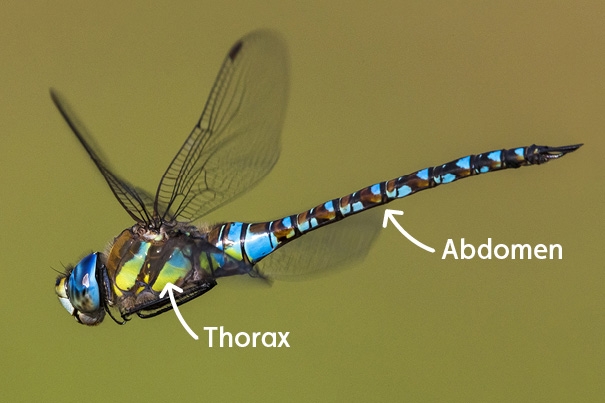
Damselflies
Banded demoiselle
Calopteryx splendens
Fluttering with slow, butterfly-like wingbeats, the males are instantly recognisable with their broad, dark wing patches and metallic green bodies, whereas the females show greenish wings.
Where to look: Common in England, Wales and Northern Ireland; search through waterside vegetation along slow-flowing rivers and streams with muddy beds.
When to look: First emerging in May, the key flight period is June and July, but they might be seen into September.


Beautiful demoiselle
Calopteryx virgo
With a blue tone to the body colour and shining, solid dark blue wings, the males of this species look like flying jewels. The females have brown wings and can be distinguished from beautiful demoiselle by having a white wing spot.
Where to look: Common in Wales and southern and western England, they can be seen in the same habitat as the banded demoiselle but are more likely to be seen in fast flowing streams and rivers, with gravel or sand beds. Normally perched on waterside vegetation.
When to look: First emerging in May, the key flight period is June and July, but they might be seen into September.


Emerald damselfly
Lestes sponsa
A metallic green damselfly, with the male showing some blue on thorax and end of abdomen. Female is a dark metallic green all over.
Where to look: Common throughout much of the UK in a wide range of waterbodies, especially those with emergent vegetation.
When to look: First emerging in June, the key flight period is July and August, but they might be seen into September.


White-legged damselfly
Platycnemis pennipes
A small damselfly, the male is pale blue and the female more cream/pale green, both with some black markings. They get their name from the hind legs being wide and white.
Where to look: Usually found near slow-flowing rivers and streams but only in south and central England and into parts of Wales too.
When to look: First emerging in May, they can be seen throughout June and July and into August.


Large red damselfly
Pyrrhosoma nymphula
Large reds are hard to miss, with their red abdomen with black segments towards the tip, which are more extensive in females.
Where to look: Common in wetland habitats throughout the UK.
When to look: First emerging in April, they can be seen throughout the summer months and into September in upland areas.

Common blue damselfly
Enallagma cyathigerum
The most widespread of the blue-and-black damselflies, they’re best separated from other blue damselflies by the broad pale stripe on the side of the thorax and two blue segments near the tip of the abdomen. Females have broad pale markings on the thorax and black 'rocket' shapes on the abdomen.
Where to look: Common throughout the UK especially at large ponds and lakes.
When to look: First emerging towards the end of April, they can be seen throughout the summer months and well into September.

Azure damselfly
Coenagrion puella
A slightly darker blue than the common blue, the male azure is best identified by narrow blue stripes on the thorax and small black markings in the furthest of the two blue segments near the tip of the abdomen. Females however share the male’s narrow pale thorax stripe, but usually appear green-blue, with a mainly black abdomen.
Where to look: Common in wetlands throughout the UK, but not in the uplands of northern England or in northern Scotland.
When to look: First emerging in April, they can be seen throughout the summer months.


Variable damselfly
Coenagrion pulchellum
Males are best identified by the broken blue stripes on the thorax and the ‘wine goblet’ shaped mark on the second segment of their abdomen (‘U’-shaped in Azure). The abdomen generally shows a lot more extensive of black, although this can vary between individuals! Females usually show black on the abdomen than female Azure.
Where to look: Patchily distributed throughout the UK, requiring well-vegetated waters, often in fens.
When to look: First emerging in late April, they can be seen throughout May, June, July and into August.

Red-eyed damselfly
Erythromma najas
Males show red eyes, a black thorax with blue sides and black abdomen, aside from the first and last segments which are all blue. The females are mainly black but their thorax has green sides and a little blue between segments on the abdomen.
Where to look: Common in much of central, southern and eastern England. Often seen settled on lily pads or other floating vegetation.
When to look: First emerging in late April, they can be seen throughout the summer months and into September.

Small red-eyed damselfly
Erythromma viridulum
Much the same in looks as the red-eyed damselfly, the crucial difference on males is a blue wedge on the side of the abdomen extending forwards from the blue terminal segments. The females are mostly black but with extensive colouring on the sides of the abdomen and thorax, which is usually green but sometimes blue or yellow.
Where to look: Across central, southern and eastern England.
When to look: First emerging in June, their peak flight period is July and August but they can be seen into September too.


Blue-tailed damselfly
Ischnura elegans
The abdomen in this species appears mostly black, but for a blue segment near the end, with the last two segments black again. The thorax is bright blue in the males but can be purple or pink in the females, some of which have a brown instead of blue segment in the abdomen. The wing-spot is black and white in males.
Where to look: Common in wetlands throughout the UK.
When to look: Can emerge from late April, but the peak flight period is June and July and they can be seen into September.


Dragonflies
Emperor
Anax imperator
One of the UK’s largest dragonflies, the emperor shows a green thorax and black central line down the abdomen, which is vivid blue in males and blue-green in females.
Where to look: Common in England and Wales. They can be found around a variety of wetlands but usually still water such as ponds and lakes.
When to look: First emerging in late May, the key flight periods are June, July and August but individuals can be seen into October.


Hairy dragonfly
Brachytron pratense
A small hawker dragonfly with a hairy thorax, and the first of the year to emerge. The abdomen has blue spots in males and yellow spots in females.
Where to look: Emergent vegetation around ponds, lakes and ditches. They’re not widespread in the UK, but are found at a variety of lowland sites.
When to look: First emerging in April, their key flight period is May and June but they can sometimes be seen into July.


Southern hawker
Aeshna cyanea
Can be distinguished from other hawkers by large pale patches at the top of the thorax as well as bands towards the end of the abdomen (all other hawkers show spots). Males have a black abdomen with mostly green markings and blue towards the end of the abdomen, whilst females have a dark brown abdomen with green, yellow or pale blue markings.
Where to look: Common across the UK but absent from large parts of Scotland and Northern Ireland. Often seen hunting in woodland clearings
When to look: They emerge from late May with key flight period being July, August and September, but can be seen well into October.


Common hawker
Aeshna juncea
This is the darkest of the hawkers, with small paired spots along the abdomen and a yellow vein at the front of each wing. The male’s abdomen is almost black in colour with blue spots, whereas the female has a brown abdomen with yellow or green spots.
Where to look: They’re only common across upland moorland and sometimes heathland with acidic water, hence their absence from the east of England.
When to look: Emerging from late June, their key flight period is July, August and into September, but they can be seen up to late October.


Migrant hawker
Aeshna mixta
Similar in looks to the common hawker but with a shorter abdomen and lighter build, the migrant hawker is dark brown in colour with yellow stripes on the thorax. They fly with a notably upwardly pointing abdomen (see our annotated anatomy image at the top of this page), which shows pairs of spots. In the male these are blue but in the female, yellow. A key identifying feature is a yellow ‘golf-tee’ shape at the base of the abdomen.
Where to look: Found in a wide variety of wetland habitats, often hanging from vegetation. Common throughout England and Wales with many migrating from the continent every summer.
When to look: They’ll start to emerge from July but the key flight time is August, September, October and can be seen into November.


Brown hawker
Aeshna grandis
Mostly brown in colour, with wings washed a golden colour. Their thorax shows two bold yellow stripes and they have small blue spots along the abdomen sides, with some females showing yellower spots.
Where to look: Common throughout much of England and Wales (but less so in the far west) and in Northern Ireland too. Can often be seen hunting along woodland clearings and meadows, near to a variety of wetland areas.
When to look: First emerging in June, their key flight period is July and August but some will be seen into October.

Golden ringed dragonfly
Cordulegaster boltonii
A large and brightly coloured dragonfly, with green eyes and black and yellow bands across the entire thorax and abdomen. Sexes alike.
Where to look: Always around running water particularly streams of woodland and heathland, where they can be seen hanging from vegetation. They’re common throughout much of Scotland, Wales and northern England, also south and west England.
When to look: Emerging from May, the key flight period is June but they can be seen into early August.

Downy emerald
Cordulia aenea
There’s a lot in a name; this dragonfly is a metallic green-bronze, with a downy thorax and bright green eyes (brown when immature). Sexes similar.
Where to look: Usually found around still waters with trees nearby, they’re patchily distributed throughout the UK, with key strongholds in central and southern England.
When to look: They can begin to emerge from late April, with key flight times being June and July.

Common darter
Sympetrum striolatum
Males have an orange-red abdomen, whilst females are yellowish. Both have a brown thorax with yellow patches on the side.
Where to look: Common throughout the UK across various wetland habitats.
When to look: Emerging from May, their key flight period is July, August and September, with some individuals still on the wing in November.


Ruddy darter
Sympetrum sanguineum
In the male the abdomen is blood-red and is slightly shorter and stockier than the common darter, whilst the thorax is red-brown. The female has a yellowish abdomen with the top of the thorax showing a dark ‘T’ marking. Both sexes have distinctive all-black legs.
Where to look: Common throughout much of England, south Wales and east Northern Ireland, they’re found in a variety of wetland habitats, normally not too far away from water.
When to look: They’ll start to emerge in June but the main flight period is July and August, but there’s a chance of seeing them well into October.


Black darter
Sympetrum danae
These small darters can instantly be separated from the others as the males are black when mature, with yellow marks on the side of the abdomen and thorax. The females show a lot more yellow all over and a dark triangle on top of the thorax.
Where to look: Common throughout the UK but with a patchy distribution throughout southern England, look for them at the margins of lakes and pools in upland moorland, sometimes in lowland heathland.
When to look: They’ll start to emerge in June but the main flight period is July and August, but there’s a chance of seeing them well into October.


Red-veined darter
Sympetrum fonscolombii
A key way to separate these from the other darters is that the lower half of their eyes are blue. In the male, the thorax is a deep red with a pale stripe across the side, and with red in the veins of the wings. The female is yellowish, with yellow wing veins.
Where to look: A relatively frequent migrant that turns up across much of England and Wales, most likely found near still water.
When to look: They’ll start to emerge in late May but key flight months are July and August, but there’s a chance of seeing them well into October.


Black-tailed skimmer
Orthetrum cancellatum
Key things to note in this species are the clear wing bases and tapered abdomen. The male’s is blue with a black tip, whilst the female is yellow with black stripes, suggesting a ladder pattern. The eyes are dull green. Typically perches on bare ground.
Where to look: Common throughout England and Wales, they can be seen in a variety of wetland habitats, such as ponds, lakes and canals.
When to look: They’ll start to emerge in May but key flight months are June and July, but there’s a chance of seeing them well into October.


Keeled skimmer
Orthetrum coerulescens
This skimmer also has a clear wing base, like the black-tailed but male keeled skimmer has a more slender abdomen that is entirely blue, whilst the female sports a black central stripe down a yellow-brown abdomen.
Where to look: Local and patchy in distribution but present across the UK; strongholds in south Wales and southwest England. Mostly found around heathland streams and pools.
When to look: They’ll start to emerge in May but key flight months are June, July and August, but there’s a chance of seeing them well into September.


Broad bodied chaser
Libellula depressa
These dragonflies sport a clear dark mark at the base of each wing and a very wide abdomen which is blue in the male and yellow-brown in the female.
Where to look: Found in a range of wetlands and common throughout England and Wales, especially new ponds.
When to look: They can be found on the wing from April, with key flight months being May, June and July, although they can be seen into September.


Four-spotted chaser
Libellula quadrimaculata
Key to identification of this species are the two black spots halfway along each wing. They are mostly brown in colour, with a black tip and yellow sides to the abdomen. Sexes alike.
Where to look: Can be found around a variety of still-water wetlands and are common throughout the UK.
When to look: They’ll start to emerge in May but key flight months are June, July and August, with a chance of seeing them well into September.

Scarce chaser
Libellula fulva
Males are like a short black-tailed skimmer, but typically perch on vegetation (unlike that species). The wing bases have a dark patch but this is hard to see. The abdomen of the female is orange/brown with central black bell-shaped markings. Females and some males have black wing-tips. Eyes obviously blue.
Where to look: Can be found in slow-flowing rivers and drains and ponds and lakes with emergent vegetation. It is restricted to southern, central and eastern England.
When to look: They have a short flight period, the key time being June but can be seen for around 1 month either side of that.


My dragonfly doesn’t look like any of the above
Dragonflies and damselflies first emerge from their underwater larval (juvenile) form, during the night and early morning (to avoid predation from birds) so if you time it well, you might see them still warming themselves on a stem. However, it’s unlikely that you will recognise them as at this time they have softer bodies and lighter colouring than their adult form. They’re known as ‘tenerals’ at this stage and have shiny wings and drab colouration; it can take a full week to gain colour. They’ll be keeping away from water where they could be damaged by aggressive mature adults, and so will seek shelter in vegetation.

Dragonflies could also be a different colour on account of their old age, when they are over-mature they can become dark and lose some of their typical colouration.
There are also at least 12 species that breed in the UK that we haven’t included here, that have very specific and tiny ranges. You might even have found a rarity, an immigrant from the Mediterranean or even America, such as vagrant emperor.

